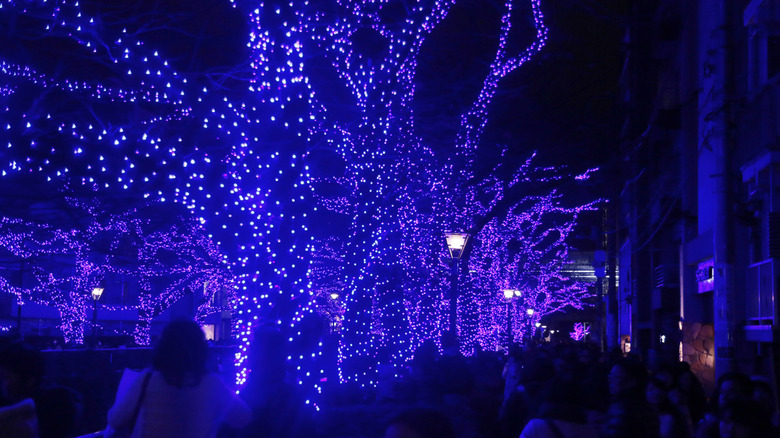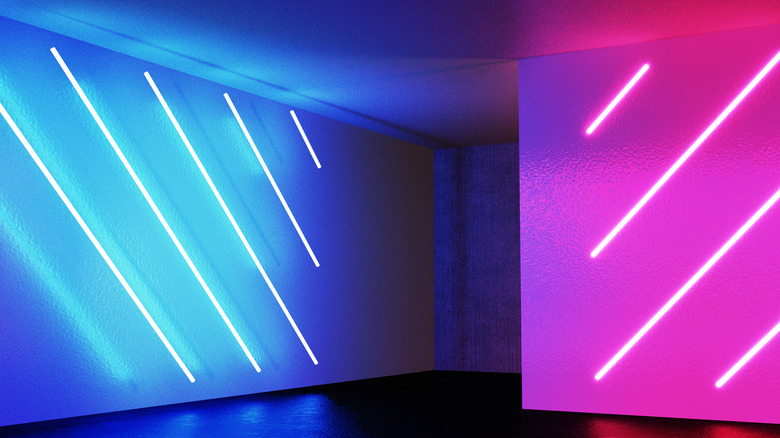What Made The Creation Of Blue LED Lights So Special?
Light-emitting diodes (LEDs) are so ubiquitous that it's easy to forget just how much society relies on these underappreciated technological wonders. Yet, the history of the LED goes back further than most people imagine, with the Russian inventor Oleg Losev first exploring the concept of solid-state luminescence in the 1920s. Although LEDs were created as early as 1927, it wasn't until 1962 that the first commercial LED product became available — the SNX-100 GaAs LED, which sold for $130. The first LEDs only emitted red light; it wasn't until 1972 that George Craford developed the yellow LED, with a green LED following in the same decade.
The blue LED can also trace its history back to the 1970s. These were initially developed by RCA with a view to making a slimline TV, and although a blue LED was developed, it wasn't bright enough to be practical. Ultimately, the project was shelved when RCA withdrew funding. It wasn't until 1992 that this problem was solved and a practical blue LED was created, a development that resulted in a Nobel Prize in Physics for Isamu Akasaki, Hiroshi Amano, and Shuji Nakamura. The importance of this cannot be overstated, as the addition of blue to the "LED palette" allowed us to save money by switching to LED lightbulbs, enabled full color LED screens, and even Blu-Ray. In short, it transformed LEDs from a useful innovation to a groundbreaking technology.
How LEDs work
To understand why blue LEDs are special, it's useful to learn the basics of LEDs and what the letters stand for. The principles of how LEDs work can be found in the surreal realm of quantum mechanics. Without going into too much detail, LEDs produce light when an electron passes through a tightly bonded laminate of two crystal layers. These two layers are semiconductors and are called the P-type and N-type layers. The P-type semiconductor is "electron rich" and the N-type is "hole-rich." When electricity is applied to the system, the electrons and holes combine at the point where the P-type and N-type layers join. This releases energy in the form of light. It's the materials used in the two layers that dictate the color of the outputted light. For blue LEDs, finding this combination was tricky.
As previously noted, the history of the blue LED can be traced back to the RCA labs of the early seventies. This was when a young engineer called Herbert Maruska had the idea that a substance called gallium-nitride (GaN) would be perfect for a blue LED. After much tinkering, he successfully created the first blue LED in 1972. However, when RCA dropped the funding, the research stopped. It wasn't until the Nobel Prize-winning breakthrough of the early nineties that a practical and bright blue LED was developed.
Why are blue LEDs special?
In terms of practical applications, the development of the blue LED was world-changing. For starters, blue LEDs allowed the development of the modern energy-efficient LED lightbulb. This can be achieved by either using the blue LED to agitate a fluorescent chemical within the bulb or, less commonly, mixing the three primary LED colors of red, blue, and green. While the latter might not be prevalent in lighting, the mixing of these colors allowed for the development of technologies like the screen you're probably reading this article on. While the concept and primitive LED screens had been around since before the blue LED "came into the picture", it was the introduction of this that completed the Holy Grail of red, blue, & green, and the full color LED screen became a reality.
The technology that underpinned the Blu-Ray system was also made possible by the development of the blue LED. Blue GaN diode lasers work at higher frequencies than other LEDs, which allows a five to ten-fold increase in storage capacities over the DVD format. A point that has lost some of its relevance in the streaming age, but is impressive nevertheless. Ultimately, the invention of the blue LED has given us everything from smart lightbulbs to smartphones, and much more. While its development was tricky, we're certainly glad that enough clever scientists could see blue light at the end of the tunnel!


